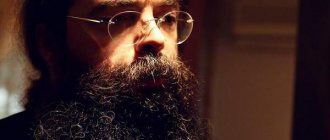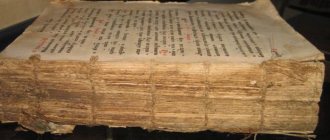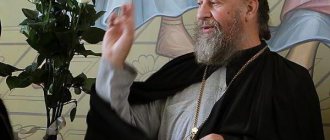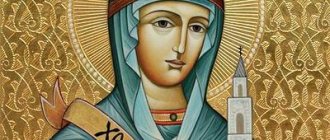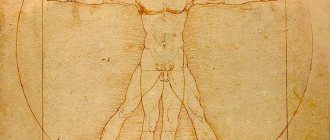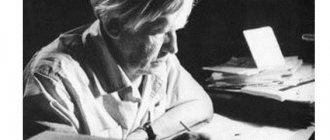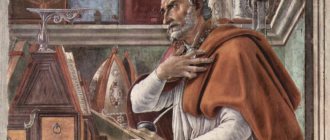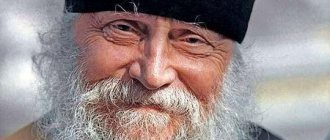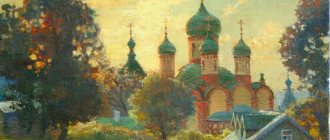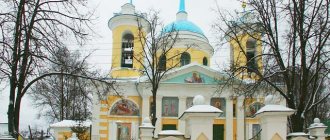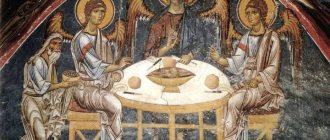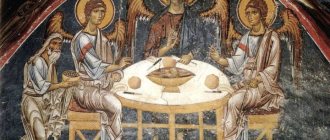People tend to complain about the times in which they live. It is common to sometimes embellish or, on the contrary, exaggerate the horrors of bygone times. Therefore, it is important to know and remember those who, regardless of the century allotted to him, cared no more about wealth, fame, career and other earthly goods.
About people who cared about the Word of God. Archimandrite Antonin Kapustin is such an example. This is a person whose name is associated with the formation and development of the Russian spiritual mission in Jerusalem.
Archimandrite Antonin Kapustin
Archimandrite - in the Russian Orthodox Church one of the highest monastic ranks, often the abbot of a large monastery.
Childhood
Archimandrite Antonin (Kapustin) was born on August 12, 1817 in a large family. On their father’s side, the Kapustins were servants of the Church and God for several generations. The mother of the future archimandrite also came from a clergyman’s family. At birth, the boy was named Andrei, he was one of six brothers, there were seven girls in the family.
The small homeland of the future archimandrite and scientist is Perm province, Shadrinsky district. Orthodoxy and the church way of life determined the style and meaning of life for the entire family. Learning to read and write began at home, and the first teacher was the father, and instead of the primer - the Psalter.
By the time the boy became a boy, his father Ivan Kapustin was appointed rector of the Transfiguration Church (the village of Baturino). Family education was short-lived; in 1826 the boy was sent for further education to the Dalmatovo Theological School, where the rules of life for students were strict, which saddened the boy a lot.
Youth
Five years later, having received a diploma of completion of the course, Andrei Ivanovich Kapustin continued his education at the Perm Theological Seminary, and later transferred to the Ekaterinoslav Seminary, where the rector was his uncle and priest Jonah Kapustin. This period was fertile in the development of Antonin, as his multifaceted abilities and talents were revealed.
Teachers noted the versatility of his interests - foreign languages (especially Greek), drawing, playing musical instruments, interest in astronomy and much more. The love of poetry remained with him until the end of his life. In 1839, the future archimandrite became a student at the Kyiv Theological Academy, and upon completion of the full course he was awarded a Master of Theology degree. He continues his activities at the academy as a teacher of German, and later as an assistant inspector.
Monasticism and teaching
The adoption of monasticism took place in early November 1845, the tonsure was performed by Metropolitan Philaret of Kiev. After the allotted time, Antonin received the rank of priest. By nature of his service, he remained a teacher of several church disciplines at the Kyiv Academy.
Classes with students were difficult for him; possessing a flexible character and high responsibility, Antonin did not know peace when preparing lectures and theoretical materials. It always seemed to him that he had not done enough, that the material contained little information or was incomplete, and sometimes he fell into insomnia, trying to bring his lectures to perfection.
In the last years of his tenure as a teacher, Father Antonin was engaged in making proofreading changes to the Russian translation of some of the works of John Chrysostom. Upon arrival at the Kyiv Academy, he began to keep diaries, describing events daily, and continued writing until the end of his days.
In the process of teaching, he studied a large number of historical documents, which awakened in him a craving for an in-depth study of the origins of Orthodoxy. He wrote about this in his diary and shared his dreams with loved ones. The Holy Synod decided to encourage the scientist’s aspirations and sent Father Antonin to Greece to serve as rector of the Athens mission.
After becoming a monk
On November 7, 1845, Andrei took monastic vows in the caves by Metropolitan Philaret of Kyiv and received the name Antonin in honor of the martyr Antonin celebrated that day. This was followed by ordination as hierodeacon and priest. For some time, the hieromonk taught accusatory theology and biblical hermeneutics at the Academy.
In 1850, he received the position of rector at the Athens Mission, where for 3 years he studied ancient Christian inscriptions and the Parthenon.
In 1859, Metropolitan of Moscow Philaret (Drozdov) recommended to the Synod that he be transferred to Constantinople to a rectorate. Archimandrite Antonin was entrusted with dealing with the Bulgarian-Uniate issue, carrying out some instructions of the Synod in connection with the accession to the Ecumenical Throne of Patriarch Sophrony, and continuing the study of the Sinaiticus Codex of the Bible.
Greek period
The Athenian period lasted 10 years, and, recalling it later, Antonin admitted that all the previous time he had been preparing for a meeting with the antiquity of the East and for understanding the unity of the Orthodox Universe. In 1853, Father Antonin was elevated to the rank of archimandrite. This period of his life marked the beginning of his passion for archaeology, history and culture of the East. At the same time, his articles appeared in the Orthodox periodical “Sunday Reading,” published by the Kyiv Theological Academy, and the book “Ancient Christian Inscriptions in Athens” was published.
Archimandrite Antonin (Kapustin) first visited Jerusalem in 1857, which made a great impression on him and was reflected in the book “Five Days on the Holy Land.” Since 1860, Father Antonin has been working in Constantinople at the embassy church. Due to the nature of his activities and assignments of the Holy Synod, he regularly goes on business trips - to Athos, Rumelia, Thessaly and other places, which he describes in the literary work “Around Rumelia”.
Over ten years of service in Greece, the scientist acquired a certain fame and authority among Greek and Russian Byzantine scholars. This is confirmed by his participation in four scientific societies, where he was accepted as an honorary member. His book on Athenian inscriptions was a huge success in scientific circles, other scientists began to refer to it, translations were made into many languages, and articles on history and archeology were also published and translated.
Excerpt characterizing Antonin (Kapustin)
- Okay, for fifty imperials - that I will drink the entire bottle of rum without taking it from my mouth, I will drink it while sitting outside the window, right here (he bent down and showed the sloping ledge of the wall outside the window) and without holding on to anything... So? ... “Very good,” said the Englishman. Anatole turned to the Englishman and, taking him by the button of his tailcoat and looking down at him (the Englishman was short), began repeating to him the terms of the bet in English. - Wait! - Dolokhov shouted, banging the bottle on the window to attract attention. - Wait, Kuragin; listen. If anyone does the same, then I pay one hundred imperials. Do you understand? The Englishman nodded his head, not giving any indication as to whether he intended to accept this new bet or not. Anatole did not let go of the Englishman and, despite the fact that he nodded, letting him know that he understood everything, Anatole translated Dolokhov’s words to him in English. A young thin boy, a life hussar, who had lost that evening, climbed onto the window, leaned out and looked down. “Uh!... uh!... uh!...” he said, looking out the window at the stone sidewalk. - Attention! - Dolokhov shouted and pulled the officer from the window, who, entangled in his spurs, awkwardly jumped into the room. Having placed the bottle on the windowsill so that it would be convenient to get it, Dolokhov carefully and quietly climbed out the window. Dropping his legs and leaning both hands on the edges of the window, he measured himself, sat down, lowered his hands, moved to the right, to the left and took out a bottle. Anatole brought two candles and put them on the windowsill, although it was already quite light. Dolokhov's back in a white shirt and his curly head were illuminated from both sides. Everyone crowded around the window. The Englishman stood in front. Pierre smiled and said nothing. One of those present, older than the others, with a frightened and angry face, suddenly moved forward and wanted to grab Dolokhov by the shirt. - Gentlemen, this is nonsense; he will be killed to death,” said this more prudent man. Anatole stopped him: “Don’t touch him, you’ll scare him, he’ll kill himself.” Eh?... What then?... Eh?... Dolokhov turned around, straightening himself up and again spreading his arms. “If anyone else bothers me,” he said, rarely letting words slip through his clenched and thin lips, “I’ll bring him down here now.” Well!... Saying “well”!, he turned around again, let go of his hands, took the bottle and brought it to his mouth, threw his head back and threw his free hand up for leverage. One of the footmen, who began to pick up the glass, stopped in a bent position, not taking his eyes off the window and Dolokhov’s back. Anatole stood straight, eyes open. The Englishman, his lips thrust forward, looked from the side. The one who stopped him ran to the corner of the room and lay down on the sofa facing the wall. Pierre covered his face, and a weak smile, forgotten, remained on his face, although it now expressed horror and fear. Everyone was silent. Pierre took his hands away from his eyes: Dolokhov was still sitting in the same position, only his head was bent back, so that the curly hair of the back of his head touched the collar of his shirt, and the hand with the bottle rose higher and higher, shuddering and making an effort. The bottle was apparently emptied and at the same time rose, bending its head. “What’s taking so long?” thought Pierre. It seemed to him that more than half an hour had passed. Suddenly Dolokhov made a backward movement with his back, and his hand trembled nervously; this shudder was enough to move the entire body sitting on the sloping slope. He shifted all over, and his hand and head trembled even more, making an effort. One hand rose to grab the window sill, but dropped again. Pierre closed his eyes again and told himself that he would never open them. Suddenly he felt that everything around him was moving. He looked: Dolokhov was standing on the windowsill, his face was pale and cheerful. - Empty! He threw the bottle to the Englishman, who deftly caught it. Dolokhov jumped from the window. He smelled strongly of rum. - Great! Well done! So bet! Damn you completely! - they shouted from different sides. The Englishman took out his wallet and counted out the money. Dolokhov frowned and was silent. Pierre jumped onto the window. Gentlemen! Who wants to bet with me? “I’ll do the same,” he suddenly shouted. “And there’s no need for a bet, that’s what.” They told me to give him a bottle. I'll do it... tell me to give it. - Let it go, let it go! – said Dolokhov, smiling. - What you? crazy? Who will let you in? “Your head is spinning even on the stairs,” they spoke from different sides. - I'll drink it, give me a bottle of rum! - Pierre shouted, hitting the table with a decisive and drunken gesture, and climbed out the window. They grabbed him by the arms; but he was so strong that he pushed the one who approached him far away. “No, you can’t persuade him like that,” said Anatole, “wait, I’ll deceive him.” Look, I bet you, but tomorrow, and now we're all going to hell. “We’re going,” Pierre shouted, “we’re going!... And we’re taking Mishka with us... And he grabbed the bear, and, hugging and lifting him, began to spin around the room with him. Prince Vasily fulfilled the promise made at the evening at Anna Pavlovna's to Princess Drubetskaya, who asked him about her only son Boris. He was reported to the sovereign, and, unlike others, he was transferred to the Semenovsky Guard Regiment as an ensign. But Boris was never appointed as an adjutant or under Kutuzov, despite all the efforts and machinations of Anna Mikhailovna. Soon after Anna Pavlovna's evening, Anna Mikhailovna returned to Moscow, straight to her rich relatives Rostov, with whom she stayed in Moscow and with whom her beloved Borenka, who had just been promoted to the army and was immediately transferred to guards ensigns, had been raised and lived for years since childhood. The Guard had already left St. Petersburg on August 10, and the son, who remained in Moscow for uniforms, was supposed to catch up with her on the road to Radzivilov. The Rostovs had a birthday girl, Natalya, a mother and a younger daughter. In the morning, without ceasing, trains drove up and drove off, bringing congratulators to the large, well-known house of Countess Rostova on Povarskaya throughout Moscow. The countess with her beautiful eldest daughter and guests, who never ceased replacing one another, were sitting in the living room. The Countess was a woman with an oriental type of thin face, about forty-five years old, apparently exhausted by children, of whom she had twelve. The slowness of her movements and speech, resulting from weakness of strength, gave her a significant appearance that inspired respect. Princess Anna Mikhailovna Drubetskaya, like a domestic person, sat right there, helping in the matter of receiving and engaging in conversation with the guests. The youth were in the back rooms, not finding it necessary to participate in receiving visits. The Count met and saw off the guests, inviting everyone to dinner. “I am very, very grateful to you, ma chere or mon cher [my dear or my dear] (ma chere or mon cher he said to everyone without exception, without the slightest shade, both above and below him) for himself and for the dear birthday girls . Look, come and have lunch. You will offend me, mon cher. I sincerely ask you on behalf of the whole family, ma chere.” He spoke these words with the same expression on his full, cheerful, clean-shaven face and with an equally strong handshake and repeated short bows to everyone, without exception or change. Having seen off one guest, the count returned to whoever was still in the living room; having pulled up his chairs and with the air of a man who loves and knows how to live, with his legs spread gallantly and his hands on his knees, he swayed significantly, offered guesses about the weather, consulted about health, sometimes in Russian, sometimes in very bad but self-confident French, and again with the air of a tired but firm man in the performance of his duties, he went to see him off, straightening the sparse gray hair on his bald head, and again called for dinner. Sometimes, returning from the hallway, he walked through the flower and waiter's room into a large marble hall, where a table for eighty couverts was being set, and, looking at the waiters wearing silver and porcelain, arranging tables and unrolling damask tablecloths, he called Dmitry Vasilyevich, a nobleman, to him. who was taking care of all his affairs, and said: “Well, well, Mitenka, make sure everything is fine. “Well, well,” he said, looking around with pleasure at the huge spread-out table. – The main thing is serving. This and that...” And he left, sighing complacently, back into the living room. - Marya Lvovna Karagina with her daughter! - the huge countess's footman reported in a bass voice as he entered the living room door. The Countess thought and sniffed from a golden snuffbox with a portrait of her husband. “These visits tormented me,” she said. - Well, I’ll take her last one. Very prim. “Beg,” she said to the footman in a sad voice, as if she was saying: “Well, finish it off!” A tall, plump, proudly looking lady with a round-faced, smiling daughter, rustling with their dresses, entered the living room. “Chere comtesse, il ya si longtemps... elle a ete alitee la pauvre enfant... au bal des Razoumowsky... et la comtesse Apraksine... j'ai ete si heureuse...” [Dear countess, how long ago... she should have been in bed, poor child... at the Razumovskys' ball... and Countess Apraksina... was so happy...] animated women's voices were heard, interrupting one another and merging with the noise of dresses and the moving of chairs. That conversation began, which is started just enough so that at the first pause you can stand up, rustle with your dresses, and say: “Je suis bien charmee; la sante de maman... et la comtesse Apraksine" [I am in admiration; mother’s health... and Countess Apraksina] and, again rustling with dresses, go into the hallway, put on a fur coat or cloak and leave. The conversation turned to the main city news of that time - about the illness of the famous rich and handsome man of Catherine's time, old Count Bezukhy, and about his illegitimate son Pierre, who behaved so indecently at an evening with Anna Pavlovna Scherer. “I really feel sorry for the poor count,” said the guest, “his health is already bad, and now this grief from his son will kill him!” - What's happened? - asked the countess, as if not knowing what the guest was talking about, although she had already heard the reason for Count Bezukhy’s grief fifteen times. - This is the current upbringing! “Even abroad,” said the guest, “this young man was left to his own devices, and now in St. Petersburg, they say, he did such horrors that he was expelled from there with the police. - Tell! - said the countess. “He chose his acquaintances poorly,” Princess Anna Mikhailovna intervened. - The son of Prince Vasily, he and Dolokhov alone, they say, God knows what they were doing. And both were hurt. Dolokhov was demoted to the ranks of soldiers, and Bezukhy’s son was exiled to Moscow. Anatoly Kuragin - his father somehow hushed him up. But they did deport me from St. Petersburg. - What the hell did they do? – asked the Countess. “These are perfect robbers, especially Dolokhov,” said the guest. - He is the son of Marya Ivanovna Dolokhova, such a respectable lady, so what? You can imagine: the three of them found a bear somewhere, put it in a carriage and took it to the actresses. The police came running to calm them down. They caught the policeman and tied him back to back to the bear and let the bear into the Moika; the bear is swimming, and the policeman is on him. “The policeman’s figure is good, ma chere,” shouted the count, dying of laughter. - Oh, what a horror! What's there to laugh about, Count? But the ladies couldn’t help but laugh themselves. “They saved this unfortunate man by force,” the guest continued. “And it’s the son of Count Kirill Vladimirovich Bezukhov who is playing so cleverly!” – she added. “They said he was so well-mannered and smart.” This is where all my upbringing abroad has led me. I hope that no one will accept him here, despite his wealth. They wanted to introduce him to me. I resolutely refused: I have daughters. - Why do you say that this young man is so rich? - asked the countess, bending down from the girls, who immediately pretended not to listen. - After all, he only has illegitimate children. It seems... Pierre is also illegal. The guest waved her hand. “He has twenty illegal ones, I think.” Princess Anna Mikhailovna intervened in the conversation, apparently wanting to show off her connections and her knowledge of all social circumstances. “That’s the thing,” she said significantly and also in a half-whisper. – The reputation of Count Kirill Vladimirovich is known... He lost count of his children, but this Pierre was beloved. “How good the old man was,” said the countess, “even last year!” I have never seen a more beautiful man. “Now he’s changed a lot,” said Anna Mikhailovna. “So I wanted to say,” she continued, “through his wife, Prince Vasily is the direct heir to the entire estate, but his father loved Pierre very much, was involved in his upbringing and wrote to the sovereign... so no one knows if he dies (he is so bad that they are waiting for it) every minute, and Lorrain came from St. Petersburg), who will get this huge fortune, Pierre or Prince Vasily. Forty thousand souls and millions. I know this very well, because Prince Vasily himself told me this. And Kirill Vladimirovich is my second cousin on my mother’s side. “He baptized Borya,” she added, as if not attributing any significance to this circumstance. – Prince Vasily arrived in Moscow yesterday. He’s going for an inspection, they told me,” the guest said. “Yes, but, entre nous, [between us],” said the princess, “this is an excuse, he actually came to Count Kirill Vladimirovich, having learned that he was so bad.” “However, ma chere, this is a nice thing,” said the count and, noticing that the eldest guest was not listening to him, he turned to the young ladies. – The policeman had a good figure, I imagine. And he, imagining how the policeman waved his arms, laughed again with a sonorous and bassy laugh that shook his entire plump body, as people laugh who have always eaten well and especially drunk. “So, please, come and have dinner with us,” he said. There was silence. The Countess looked at the guest, smiling pleasantly, however, without hiding the fact that she would not be at all upset now if the guest got up and left. The guest's daughter was already straightening her dress, looking questioningly at her mother, when suddenly from the next room several men's and women's feet were heard running towards the door, the crash of a chair being snagged and knocked over, and a thirteen-year-old girl ran into the room, wrapping something in her short muslin skirt, and stopped in the middle rooms. It was obvious that she accidentally, with an uncalculated run, ran so far. At the same moment a student with a crimson collar, a guards officer, a fifteen-year-old girl and a fat, ruddy boy in a children's jacket appeared at the door. The count jumped up and, swaying, spread his arms wide around the running girl. - Oh, here she is! – he shouted laughing. - Birthday girl! Ma chere, birthday girl! “Ma chere, il ya un temps pour tout, [Darling, there is time for everything,” said the countess, pretending to be stern. “You keep spoiling her, Elie,” she added to her husband. “Bonjour, ma chere, je vous felicite, [Hello, my dear, I congratulate you,” said the guest. – Quelle delicuse enfant! “What a lovely child!” she added, turning to her mother. A dark-eyed, big-mouthed, ugly, but lively girl, with her childish open shoulders, which, shrinking, moved in her bodice from fast running, with her black curls bunched back, thin bare arms and small legs in lace pantaloons and open shoes, I was at that sweet age when a girl is no longer a child, and a child is not yet a girl. Turning away from her father, she ran up to her mother and, not paying any attention to her stern remark, hid her flushed face in the lace of her mother’s mantilla and laughed. She was laughing at something, talking abruptly about a doll that she had taken out from under her skirt.
Jerusalem period
In 1865, the Russian spiritual mission in Jerusalem received a new head - Archimandrite Antonin. At first he was acting, and in 1869 he was confirmed in office. In the Russian Spiritual Mission of those years there was discord between the priests, intrigues were woven, which is why pilgrims and the very status of the church suffered. The newly arrived archimandrite had to show miracles of diplomacy. In this field, Father Antonin accomplished many things, gaining fame for the Russian clergy and establishing the presence of the Orthodox Church in Jerusalem.
The period of his active work is still called the “Golden Age” of the mission; Russian Palestine was founded and flourished through his labors. The creation of a powerful infrastructure became possible thanks to the efforts of the archimandrite. During his work, he strengthened the position of the Russian Orthodox Church by acquiring land plots, founding monasteries, building pilgrimage centers, and a school for Arab children.
In addition to strengthening the position of the church, he studied biblical culture and antiquities. He was the first who realized the need to preserve Old Testament shrines and, in order not to lose them, began to acquire plots of land associated with legends. Having carried out excavations on them, he built temples, founded monasteries and centers to accommodate pilgrims. With his arrival, the passions and intrigues in the mission did not subside, but he was able to find a common language with all sides of the conflict and even to some extent reconcile the antagonists.
Notes
- Pilgrimage to the Holy Land. 150 years of the Russian Spiritual Mission in Jerusalem. 1997, p.323
- Ezhkova L.
[orthodox.etel.ru/2010/03/rod.htm The Kapustin family of priests left a noticeable mark on the history of the Russian Orthodox Church] // Orthodox newspaper. Ekaterinburg. — 2010. - Until 1917, being named in the patronymic with -vich was considered a special privilege; such a right was granted to ordinary people personally by the emperor for special merits (famous people)
- [www.filaxi.com/Library/index.php?id=p1_24 From the book by Cyprian Kern. Father Antonin Kapustin - head of the Russian Spiritual Mission in Jerusalem, - Op.: Belgrade, 1934. 195 p. 2nd ed.: M., 1997.]
- [www.nm45.ru/novosti/obschestvo/mezhdu-proshlym-i-buduschim.html Valentina Tselousova: Between the past and the future - Kurgan regional socio-political newspaper “NEW WORLD”]
- ↑ 123
[heritage.perm.ru/articles.php?lng=ru&pg=3237 Antonin, Archimandrite, head of the Russian spiritual mission in Jerusalem] - [jerusalem-ippo.ru/history/rs/g/ Temple of St. Mary Magdalene in the Garden of Gethsemane in Jerusalem]. Pavel Viktorovich Platonov. Jerusalem branch of the Imperial Orthodox Palestine Society. July 2, 2011
- [palomnic.org/sz_sr/personalii/arx_antonin/tser/ O. L. Tserpitskaya. Archimandrite Antonin (Kapustin) and Russian shrines in the Holy Land
] - Chairman of the IOPS Sergei Stepashin welcomed the participants of the scientific conference in memory of Archimandrite Antonin (Kapustin). [jerusalem-ippo.ru/news/273/ Publication on the official portal of the Jerusalem branch of the Imperial Orthodox Palestine Society] dated April 23, 2014.
- ↑ 1 2 3 Vengerov S. A.
A. // [runivers.ru/upload/iblock/c8d/Vengerov%20S.A.%20Kritiko-bibliograficheskij%20slovarc%20russkix%20pisatelej%20i%20uchenyx.%20Tom%201. %20Vypuski%201-21.%20A%20y1889cvruur1200sm.djvu Critical-biographical dictionary of Russian writers and scientists (from the beginning of Russian education to the present day)]. - St. Petersburg: Semenovskaya Typo-Lithography (I. Efron), 1889. - T. I. Issue. 1-21. A. - S. 1. - [rusdm.ru/history/36 HISTORY OF THE RUSSIAN SPIRITUAL MISSION IN JERUSALEM. CHAPTER III]
Mamre oak
Not wanting to take part in the discord, Archimandrite Antonin (Kapustin) decided that he would concentrate his efforts on the main task of the monk - serving God and the Church. Bearing in mind that one of the tasks of the mission was to provide shelter and safety for pilgrims, he began to expand the territory of Russian Orthodoxy in the Holy Land.
His very first acquisition was the Mamre Oak in the city of Hebron. It was issued to the permanent assistant of Antonin's father, Jacob Halebi, which is due to certain restrictions on the rights to acquire land in the Ottoman Empire. Land could be purchased by private individuals, subjects of the Port. It was almost impossible to buy Mamvrian oak, but courage, perseverance, diplomacy and money made it possible to convince the owner of the transaction.
The oak tree is one of the Christian shrines; the Holy Trinity appeared to Abraham near it. To expand the territory, Father Antonin bought up plots of land in the district, which totaled 72 thousand square meters. The first liturgy on this land was celebrated in June 1869, the site was gradually improved, and a large pilgrimage house was built. The temple was erected in 1925. Pilgrimage trips to the Oak of Mamre are still one of the revered destinations among believers.
Mount of Olives
The second major object that was added to the Russian Spiritual Mission in Jerusalem was the monastery on the Mount of Olives. Knowing from the works of Dmitry of Rostov that the head of John the Baptist rests in those places, and from other sources about the many Christian monasteries located on Olivet since the 6th century, he undertook to buy land on its slopes. Excavations were carried out on the acquired properties. Their result was unique finds - the remains of ancient Byzantine temples with wonderfully preserved mosaic floors, a bust of the ruler Herod the Great, burial caves and much more.
The main shrines were the found stone on which (according to legend) the Mother of God stood during the Ascension of the Savior, and the foundation of an ancient Christian church, where the altar was preserved. Almost immediately after the completion of all the survey work, Archimandrite Antonin became concerned with the foundation of the temples, but the outbreak of the Russian-Turkish conflict stopped construction for some time.
The Church of the Ascension of the Lord was opened in 1886, its foundation was an ancient temple. Now on the lands acquired by Father Antonin there is a convent where the main shrines are the places where the head of John the Baptist was found; on the floor in the chapel there is a recess in the mosaic floor indicating the place where the head of John the Baptist was found. Here, on the Mount of Olives, the ashes of Archimandrite Antonin rest, and pilgrimage trips are made to him.
Literature
- Cyprian (Kern).
RDM ROCOR Ascension Monastery (Mount of Olives) • Gethsemane Monastery • Holy Trinity Monastery (Hebron) • Skete of St. Chariton • Russian School in Bethany IOPS Sergievskoe metochion in Jerusalem • Alexander's metochion • Threshold of the Gate of Judgment • Church of St. Alexander Nevsky (Jerusalem) • Sergievskoe metochion in Nazareth • Veniaminovskoe metochion • Nikolaevskoe metochion • Elizabeth's metochion • Mariinsky metochion • Women's teachers' seminary in Beit Jala • Men's teachers' seminary in Nazareth • Seaside site in Haifa Buildings of "Russian buildings" Holy Trinity Cathedral • Russian Spiritual Mission in Jerusalem • Russian Consulate General • Sergievsky Compound • St. Nicholas Compound • Elizabethan Compound • Mariinsky Compound • Russian Hospital Key personalities Andrey Muravyov • Porfiry (Uspensky) • Boris Mansurov • Antonin (Kapustin) • Yakub Halebi • Leonid (Kavelin) • Leonid (Sentsov) • Sergey Alexandrovich • Elizaveta Fedorovna • Vasily Khitrovo • Dmitry Smyshlyaev • Alexander Yakovlev • Alexey Dmitrievsky • Nikolay Koshelev • Alexander Kezma • Anthony (Sinkevich) • Klavdiya Ode-Vasilieva Other Palestinian Committee • Palestinian Commission • Orange Deal
What else has been added to the Russian Mission?
The Russian Spiritual Mission in Jerusalem through the works of Archimandrite Antonin acquired weight, authority and took its rightful place in the hierarchy of Orthodoxy in the Holy Land. During his tenure in office, Father Antonin increased the ownership of many lands, where the property of the church is now located, and pilgrims have the opportunity to touch the shrines:
- Air Karem, the place where John the Baptist was born, and the Mother of God spent three months visiting the righteous Elizabeth. Having first bought one house with a plot from a local resident, the archimandrite increased his holdings to almost 300 thousand square meters. The estate began to be called Gorny. In 1882, a temple was consecrated here, nuns were invited, allocating each a separate house with a small plot for a garden. The monastery still exists today.
- Hospice house in Jaffa near the burial place of Saint Tabitha. In 1888, a temple was built on the acquired lands, consecrated in honor of the righteous Tabitha and the Apostle Peter. For a long time, this courtyard was considered the best in the Russian mission of Jerusalem, it was called the “Golden Pearl”.
- Pilgrimage shelter in Jericho with tropical garden.
- Hotel house on the shore of the Sea of Galilee in Tiberias.
- An estate in Gethsemane, where the Church of Mary Magdalene was built. It contains the relics of Elizabeth Feodorovna, the Grand Duchess.
- In the village of Siloam, a plot of land was acquired, including the caves of the Siloam monolith.
- Rumaniye Cave is located in the Suahiri Valley.
- On the Mount of Olives are located the “Prophetic Sepulchers” acquired by Father Antonin, “the place of Kallistratus”.
- A plot of land in the birthplace of St. Mary Magdalene, in the city of Magdala. In Father Anton's plans, it was intended to be a pilgrimage shelter.
- A plot of land in Cana of Galilee, adjacent to the place where the house of the Apostle Simon the Canonite was located.
According to general estimates, over the years of his activity as director of the Russian Spiritual Mission in Jerusalem, Archimandrite Antonin increased the church’s holdings to 425 thousand square meters. meters of land, which in monetary terms is about 1 million rubles in gold. Unfortunately, most of this priceless wealth was lost during Khrushchev's reign. According to some sources, most of the heritage was given away for meager money, carried out as a barter operation - buildings and land in exchange for oranges and cheap fabrics.
Acquired plots
In 1869, with the assistance of Archimandrite Antonin, the Mamvrian oak was acquired, and a little later the nearby lands (about 72,355 m) were purchased. On June 12, 1869, the head of the mission celebrated the first Divine Liturgy at the site of the appearance of the Holy Trinity to Abraham. In 1870, the top of the Mount of Olives was acquired.
At the same time, the largest possession of the Russian Empire was acquired in the Holy Land in Ein Karem.
In the same years (1869), Kapustin acquired an estate near Jaffa on the way to Jerusalem - the burial place of Saint Tabitha, where the Church of the Apostle Peter was built. A farmstead for pilgrims' rest was also purchased in Tiberias.
In Beit Jala, Antonin bought two properties, on one of which a school for girls and a female teachers' seminary were founded.
In Gethsemane, he successfully acquired a place where, at the request of the royal family, the Church of St. Mary Magdalene, Equal-to-the-Apostles, was built.
In total, Archimandrite Antonin purchased and legally registered 13 plots, with an area of about 425,000 m, worth up to a million rubles in gold.
Antonin zavakufiled his real estate (that is, the property is not subject to sale, exchange or other transactions leading to their alienation until Antonin’s death, and then passes into the possession of the Synod; if the Synod ceases to exist, then these lands become the property of all Orthodox Russian people, and if and they disappear, then the lands come to the disposal of the Jerusalem Qadi.
Literary and scientific heritage
The biography of Archimandrite Antonin Kapustin is not limited only to his activities in the creation of Russian Palestine. He found time to study ancient manuscripts, study archaeology, numismatics, Byzantine studies, translations and much more.
In 1859, research was carried out and ancient manuscripts stored in the St. Panteleimon Monastery on Athos were described. In 1867, Father Antonin studied the manuscripts in the Patriarchal Library of Jerusalem. A year later, he compiled a catalog of early printed editions and manuscripts of the Lavra of St. Sava the Sanctified. In 1870, in the library of the monastery of the Great Martyr Catherine (Sinai), he compiled a description and catalog of Greek (1310 units), Slavic (38 units), Arabic (500 units) manuscripts. For this work, a unique document was received as a gift - the Kyiv Glagolitic Leaves (transferred to the library of the Kyiv Theological Academy).
The period of stay in Jerusalem for the archimandrite was the most fruitful in scientific research. His personal library of ancient manuscripts increased significantly; it included texts and books in Greek, Old Slavic, and Arabic. The collection of antiquities collected throughout his life was constantly replenished with coins, ancient household items, and monuments of Byzantine art. The collection of unique manuscripts collected over a lifetime is partly located in the Central Scientific Library of the National Academy of Sciences of the Kiev-Pechersk Lavra and in the Russian National Library, RGIA of St. Petersburg.
ANTONIN
(Kapustin Andrey Ivanovich, 08/12/1817, village of Baturino, Shadrinsky district, Perm province - 03/24/1894, Jerusalem), archimandrite, Byzantine scholar, church leader, whose name is associated with the heyday of the Russian spiritual mission in St. .ground Parents, priest Ioann Leontievich Kapustin and Maria Grigorievna Varlakova came from families of priests. Andrei Kapustin was educated at the Dalmatovsky Children's School and the Perm, and then Ekaterinoslav Children's School, in 1839-1843. studied at the KDA, upon graduation he was awarded a master's degree in theology (1844), and left to teach it. and Greek languages, Oct. 1845 became a bachelor of the academy. 7 Nov the same year he was tonsured a monk with the name A. Metropolitan. Kyiv Filaret (Amphitheater). Since 1846, he held various administrative positions. positions in the CDA, taught in the departments of moral theology (1846), biblical hermeneutics and accusatory (comparative) theology (1847). Along with this, on behalf of the academy in 1845-1850. was engaged in correcting Russian. translation of the homilies of St. John Chrysostom, wrote articles and sermons.
On May 15, 1850, A. was appointed rector of the church under the Russian. embassy in Athens. One of his most important undertakings was the restoration of the ancient Athenian church, which was in ruins. Lycodemus (St. Nicodemus, early 11th century), begun in December. 1851 with Russian money. government and completed in 1855. After restoration, this temple, consecrated in the name of the Holy Trinity, was transferred to Russia and became Russian. embassy church. All construction work, the painting of the temple, as well as the archaeological excavations that preceded the restoration of the church were carried out hand in hand. A., who is a reward for his labors on April 5. 1853 The Holy Synod of the Russian Orthodox Church elevated him to the rank of archimandrite (the rank was performed by Metropolitan Neophyte of Attica). At the same time, he collected, studied and later published more than 200 Christians. inscriptions of Athens VI-XII centuries. (About ancient Christian inscriptions in Athens. St. Petersburg, 1874). During his stay in Greece, A. began to describe ancient manuscripts, made trips to Rome (1852), Jerusalem and Egypt (1857), having the opportunity to get acquainted with various manuscript collections. In 1859, he undertook his first trip to Athos, where he devoted a lot of time to researching ancient manuscripts and books, as well as compiling descriptions of several. monastic book depositories. At this time he met Archimandrite. Porfiry (Uspensky), with whom he led later. correspondence.
Archim. Antonin (Kapustin) Arkhim. Antonin (Kapustin)
In 1860-1865 A. was the rector of the embassy church in K-pol. This was the period of his most fruitful scientific activity. In 1862, he compiled a catalog of 624 manuscripts from the library of the Jerusalem Holy Sepulcher Metochion in K-pol (published: Dmitrievsky A. A. Travel in the East and its scientific results. K., 1890. P. 119-148), in Krom A. first drew the attention of scientists to a unique handwritten collection containing the text of the Didache. In April 1862 A. visited the city of Nicaea (Iznik) and its environs (materials about a trip to Bithynia and sketches published in KhCh in 1862-1863). In the spring of 1863, A., having received leave, was able to travel to his homeland for the only time in his more than 40-year stay in the East; On his way to Baturino to visit his parents, he visited the largest scientific centers in Europe and Russia (Vienna, Prague, Dresden, St. Petersburg, Moscow) and book collections of the largest libraries, and met the best specialists in the field of Slavic and Byzantine studies. In the same year, on behalf of the Holy Synod, A. investigated on Mount Athos the question of the authenticity of the Codex Sinaiticus of the Bible, confirming its antiquity, and in 1868 he negotiated in K-Pole for the final transfer of this most valuable manuscript to the Russians. government. In May-July 1865, he traveled through the Balkan provinces of the Ottoman Empire (Macedonia, Thessaly, Epirus), collecting rich archaeological material on church history in his travel diaries (To Rumelia. St. Petersburg, 1879; From Rumelia. St. Petersburg, 1886) .
In 1865, A. was appointed temporary head of affairs of the Russian Ecclesiastical Mission in Jerusalem (June 5, 1869, confirmed as its head). The mission, founded in 1847, was at that time in difficult relations with the Patriarchate of Jerusalem and representatives of other confessions in Palestine, and also experienced extreme shortages of funds necessary for its work. A. thanks to a subtle understanding of the political and church situation in Christ. East, excellent knowledge of Greek. and a number of eastern languages and diplomatic talent, combined with personal charm, managed to gradually improve the position of the Russian mission and strengthen its authority in Palestine. Having achieved a more attentive attitude towards her from the Russian side. government and the Holy Synod, A. managed to create a serious material basis for the activities of the mission in Palestine and significantly expand the existing Russian system. pilgrimage to the Holy Land.
Through A.’s efforts and with donations received from private individuals, land was acquired around the Mamre Oak and on the Mount of Olives, where a Russian building was built according to A.’s design. Monastery of the Ascension of the Lord. Before starting construction, A. conducted archaeological excavations at this site, during which it was possible to discover ancient mosaics (VI-IX centuries) and burial caves. Soon, a plot of land was purchased in Ain Karem, near Jerusalem, where the Russian building was built. Gornensky female mon-ry. On a plot purchased in Jaffa, hand in hand. A. An underground necropolis was excavated, identified with the burial place of rights. Tabitha. Land plots were also acquired in Jericho, Tiberias, Beit Jala, Bethlehem, Siloam and Anath (see Anathoth).
In 1883, on behalf of the leader. book Sergius Alexandrovich, Chairman of the Imp. Palestinian Orthodox Society, on a plot belonging to the Society next to the Church of the Resurrection of the Lord, under the hands of. A. archaeological excavations were carried out, during which the “Doomsday Gate” was discovered, as well as the remains of a basilica built in the 4th century. equal to imp. Constantine the Great. The excavations of this place created a sensation in science, providing rich material both for the history of earthly life and the last days of the Savior, and for the history of Christ. buildings from the era of Constantine the Great in Palestine. At a personal request, he led. book Sergius Alexandrovich A. took over the leadership of the construction of the center. in the name of St. equal to Mary Magdalene in Gethsemane (1885-1888).
Burial place of Archimandrite. Antonina (Kapustina) in the Ascension Cathedral on the Mount of Olives
Burial place of Archimandrite. Antonina (Kapustina) in the Ascension Cathedral on the Mount of Olives
On the instructions of A., shelters for pilgrims and schools for Orthodox children were built on the lands he acquired. Arabs. A museum was created at the mission. At the end of his life, A. managed to register 6 of the 12 plots he acquired as “waqf” that belonged to him (a special form of religious land ownership in Muslim law); according to A.'s will, all of his landholdings (except for one plot) were left to the Holy Synod of the Russian Orthodox Church. Russia's ownership of the remaining plots was officially formalized after the death of A. Rus. Consul General A. G. Yakovlev.
In the 2nd half. 60 XIX century A. participated in the preparation for the publication of Russian acts. Monastery of St. Panteleimon on Athos (Acts of the Russian on St. Athos Monastery of the Holy Great Martyr and Healer Panteleimon. K., 1873). In Oct.-Nov. 1867 A. studied the manuscripts of the Patriarchal Library in Jerusalem, cargo. manuscripts of the Monastery of the Cross, in June 1868 he worked on a catalog of manuscripts and early printed books of the Lavra of St. Savva the Sanctified (approx. 700 storage units). From the beginning Aug. until 18 Sep. In 1870, he and his assistants compiled a description of 1310 Greek, 38 Glory. and 500 Arab. manuscripts of the library of the Mon-rya VMC. Catherine in Sinai (not published and formed the basis for W. Hardthausen’s catalog published in Leipzig in 1886); For this work, A. received a unique manuscript as a gift from the brethren of the monastery - the so-called. Kyiv Glagolitic sheets, which he later transferred to the KDA library. During the Palestinian period, A.'s personal collection of manuscripts expanded, including, in addition to Greek. there were also glory. (Cyrillic and Glagolitic), Arabic. and ancient Hebrew manuscripts, Greek and glory old printed books, Byzantine monuments. art, coins (the bulk of them were donated to the IOPS, see I. V. Pomyalovsky. Description of ancient and medieval coins donated to the Orthodox Palestine Society by Archimandrite Antonin, head of the Spiritual Mission in Jerusalem. St. Petersburg, 1886). A. owns a study that revealed confusion in the hagiographic tradition of information about St. Nicholas of Myra with the life of St. Nicholas Pinarski, his scientific contribution as an archaeologist and liturgist is significant.
A.'s scientific merits were noted by his election as a member of numerous scientific societies and institutions in Russia and Europe: the Athens Archaeological Society (1854), the Odessa Society of History and Antiquities (1856), Imp. Russian Archaeological Society (correspondent member since 1857, honorary member since 1884), Moscow Society of Lovers of Spiritual Enlightenment (1869), KDA (1870), German East. Archaeological Society (1872), Kyiv Church Archaeological Society (1873), SPbDA (1873), Imp. Orthodox Palestine Society (1882), MDA (1888), etc. For his diligent work, he was noted by many states. and church awards. A. was buried in the Cathedral of the Ascension of the Lord, which he built, on the Mount of Olives in the Russian Ascension Monastery. The collection of manuscripts he collected (about 100 items) was acquired by the Emperor in 1898-1899. Public library; in the present time is stored in Kyiv (CNB NASU, Kiev Pechersk Lavra) and St. Petersburg (RNB, RGIA). A.'s epistolary heritage is not systematized and is located in different funds.
Works: Circle of moving holidays of the Church: Collection. words, conversations and teachings. K., 1850. Part 1; Christian antiquities of Greece // ZhMNP. 1854. Part 81. Dept. 2. pp. 31-68, 142-230; Letter from Jerusalem // Kh. 1857. Part 2. pp. 203-206; News from the East // Spiritual Conversation: Church Chronicle. 1860. No. 50. P. 770-782; About the excavations inside the Russian embassy church in Athens // Izv. Imp. Archaeol. About-va. St. Petersburg, 1861. T. 2. Issue. 3. P. 129-145; From the East: About the theological school on the island of Halki. St. Petersburg, 1862; Trip to Bithynia // KhCh. 1862. Part 2. Nov. pp. 660-701; Bithynia // Ibid. 1863. Part 1. March. pp. 422-460; Part 2. May. pp. 67-124; June. pp. 229-269; Aug. pp. 493-525; Notes from a fan of the Holy Mountain // TKDA. 1860-1863 (department: K., 1864); Notes of the 12th-15th centuries related to the Crimean city of Sugdee (Sudak), attributed to the Greek Synaxar // ZapOOID. 1863. T. 5. P. 595-628; Five days in the Holy Land and in Jerusalem, in 1857 M., 1866; Preaching circle of the moving holidays of the Church: Words and conversations. M., 1867. Part 1: Lenten Triodion; Part 2: Colored Triodion; Theological school near Jerusalem // DB. 1868. T. 2. No. 37. P. 161-169, 181-191; No. 40. P. 234-242; January 26th at the Lavra of St. Savva // TKDA. 1868. No. 4. P. 42-83; The Torment of St. Domnina // Ibid. 1869. No. 1. P. 120-133; From the Bosphorus to Yafa. K., 1869; St. Nicholas, bishop Pinarsky and Archimandrite Zionsky // TKDA. 1869. No. 6. P. 445-497 [new data on the life of St. Nicholas of Myra]; Transfer of the relics of Saint and Wonderworker Nicholas from Lycia to Italy // Ibid. 1870. No. 5. P. 396-427; From the notes of the Sinai pilgrim // Ibid. 1871. T. 2. P. 275-407; T. 4. P. 68-104; T. 8. P. 274-332; 1872. T. 5. P. 272-342; 1873. T. 3. P. 363-434; T. 9. P. 324-400; Words spoken in Jerusalem on St. Golgotha on the evening of Great Friday during the covering of the shroud // Ibid. 1871. No. 4. P. 219-224; 1875. No. 6. P. 818-822; 1876. No. 5. P. 410-417; More about Saint Nicholas of Myra // Ibid. 1873. No. 12. P. 241-288; Ancient Canoner of the Sinai Library // Ibid. 1874. No. 5. P. 95-216; No. 6. P. 458-497; About ancient Christian inscriptions in Athens. St. Petersburg, 1874; Dr. Sepp: (Dr. Sepp’s story from the current state of the Samaritan community in the East) // TKDA. 1875. No. 10. P. 90-107; Pharaoh, Moses and Exodus // Ibid. 1875. No. 11. P. 249-271; No. 12. P. 455-472; St. prpmts. Sosanna of Palestine // Ibid. 1877. No. 2. P. 380-405; About how Dr. Sepp discovered the ancient temple of Baal between Jerusalem and Bethlehem // Ibid. 1878. No. 3. P. 637-657; Tomb of Aaron on Mount Hor // Ibid. 1879. No. 3. P. 356-371; The word spoken on St. Golgotha in Jerusalem April 18 1880 during the wearing of the Shroud // Kh. 1880. Part 2. July/Aug. pp. 132-137; Discourse on the Great Canon, delivered in Jerusalem before the Russian. pilgrims at Compline Thursday of the 1st week of Great Lent February 11 1882 // Ibid. 1883. Part 1. pp. 297-308; Regarding the translation of one church song of the canon (irmos 9 songs of the canon in Maundy Thursday), published in the Christian Church for 1883 // TKDA. 1883. No. 7. P. 515-526; Excavations at a Russian site near the Church of the Resurrection in Jerusalem // PPS. 1884. No. 7 (Vol. 3. Issue 1); About excavations at a Russian site in Jerusalem // ZRAO. n. With. 1887. T. 2. Issue. 3. pp. 182-186; Letters to Rev. Macarius (Bulgakov), later. Metropolitan Moskovsky // Wanderer. 1896. No. 1. P. 79-84; Letters to Archpriest S. A. Serafimov // TKDA. 1906. No. 8/9. pp. 680-710; No. 10. P. 108-135; No. 11. P. 361-383; 1908. No. 2. P. 237-265; No. 3. P. 404-421; Ancient Christian grave in Palestine // BT. 1999. Sat. 35. pp. 115-119; Russia in the Holy Land: Documents and materials / Comp. N. N. Lisova. M., 2000. 2 vols. Passim.
Lit.: Ternovsky S.A. About the last days of life, death and burial of the abbot Rus. Spiritual mission in Palestine Archimandrite. Antonina. K., 1894; Ponomarev S. In memory of Fr. archim. Antonina. 1: Chronological list of his works and translations. 2: Articles about him // TKDA. 1894. T. 3. No. 12. P. 636-652; Dmitrievsky A. A. Head of the Russian Spiritual Mission in Jerusalem, Archimandrite. Antonin (Kapustin) as a figure for the benefit of Orthodoxy in the East and in particular in Palestine // SIPPO. 1904. T. 15. Issue. 2. P. 95-148; The same // TKDA. 1904. Nov. pp. 319-380; Cyprian (Kern), archimandrite. O. Antonin Kapustin, archimandrite. and head of the Russian spiritual mission in Jerusalem (1817-1894). Belgrade, 1934. M., 1997p; Ilyich I., priest. Archim. Antonin (Kapustin) and his church activities in Palestine: Course. op. / LDA. L., 1960. RKP.; Goenko S., diac. archim. Antonin (Kapustin): His life, liturgical and archaeological activities: Course. op. / MDA. Zagorsk, 1976. RKP.; Salmina M.A. Diary of Archimandrite. Antonina (Kapustina) // TODRL. 1973. T. 27. P. 420-430; Fonkich B. L. Antonin Kapustin as a collector of Greek manuscripts // DRI: Manuscript book. Sat. 3. M., 1983. P. 368-379; Isaiah (Belov), abbot. Research by archim. Antonina (Kapustina) in Sinai // BT. 1985. Sat. 26. P. 315-325; Filippov M.V. On the scientific and literary activities of Archimandrite. Antonina (Kapustina) // BT. 1986. Sat. 27. pp. 212-219; Παπουλίδης K. K. Kapustin (1817-1894) κή τῆς Ρωσίας στή Χριστιανική ̓Ανατολή τό ῾9ο αἰώνα. Θεσσαλονίκη, ῾99῎; Polyakov F. B., Fonkich B. L. A. A. Dmitrievsky and his work on Russian. collectors of manuscripts and early printed books // Byzantinorussica. 1994. No. 1. P. 161-197; Nikodim (Rotov), Metropolitan. History of the Russian spiritual mission in Jerusalem. Serpukhov, 1997. P. 202-270; Guruleva V.V. Archim. Antonin as a numismatist // Numismatic collection, 1998 / State University. St. Petersburg, 1998. pp. 235-243; Gerd L. A. Archim. Antonin Kapustin and his scientific activities: (According to materials from the St. Petersburg archives) // Manuscript heritage of Russian Byzantinists in the archives of St. Petersburg. St. Petersburg, 1999. P. 8-35; Lisova N.N. Russian Spiritual Mission in Jerusalem: history and spiritual heritage // BT. 1999. Sat. 35. P. 36-51; aka. Archimandrite Antonin (Kapustin) - researcher of the Sinai manuscripts: Through the pages of a diary // Church in the history of Russia. M., 2000. Sat. 4. pp. 197-207.
B. L. Fonkich, E. P. G.
Diaries
Archimandrite Antonin conducted extensive correspondence and was engaged in scientific works. The bibliographic list of published lifetime and posthumous works currently includes more than 140 titles. One of the important historical documents is his personal diaries, published under the general title “The Tale of Bygone Years” (30 volumes). He led them daily from 1817 until his death in 1894.
The diaries of Archimandrite Antonin Kapustin were considered lost for a long time, but they have survived. The main part is located in the Russian State Historical Archive (St. Petersburg, Collection of the Holy Synod).
To date, two volumes of The Tale of Bygone Years have been published. The first volume contains entries for 1881 and describes the beginning of work in the East. The second volume was published in 2013, it contains records for 1850 - the beginning of the Athenian and Constantinople periods of the life of Archimandrite Antonin. The following volumes of diaries are also being prepared for publication.
200th anniversary
In August 2022, Russia celebrated the 200th anniversary of Archimandrite Antonin Kapustin. In the ascetic’s homeland, in the village of Baturino, the festival “Baturino Shrine” was held. A bust of Archimandrite Antonin was installed next to the ancestral Church of the Transfiguration of the Kupustin family.
Celebrations also took place in Jerusalem. A divine service was held on the Mount of Olives in the Spaso-Voznesensky Convent, led by Metropolitan Hilarion. At the end of the service, a memorial service was held at the grave of the ascetic.
A memorial service was also celebrated at the Russian Spiritual Mission. It was held in the house church, consecrated in honor of the holy martyr Queen Alexandra. A service, solemn ceremonies, and a festive reception took place in the Holy Ascension Church.
During the celebrations, a small exhibition of rare documents related to the activities of the archimandrite was opened, and the book “Archimandrite Antonin (Kapustin)” was presented. Sermons and translations of the Kyiv years." She received a response from readers. There was a viewing of the documentary film “Archimandrite Antonin (Kapustin) - the builder of Russian Palestine.”
The literary and scientific heritage of Archimandrite Antonin in its value can be the same pride of the country and the church as all his activities in the creation of Russian Palestine.
Essays
- Circle of moving holidays of the Church: Collection. words, conversations and teachings. K., 1850. Part 1;
- Christian antiquities of Greece // ZhMNP. 1854. Part 81. Dept. 2. pp. 31-68, 142-230;
- Letter from Jerusalem // Kh. 1857. Part 2. pp. 203-206;
- News from the East // Spiritual Conversation: Church Chronicle. 1860. No. 50. P. 770-782;
- About the excavations inside the Russian embassy church in Athens // Izv. Imp. Archaeol. About-va. St. Petersburg, 1861. T. 2. Issue. 3. P. 129-145;
- From the East: About the theological school on the island of Halki. St. Petersburg, 1862;
- Trip to Bithynia // KhCh. 1862. Part 2. Nov. pp. 660-701;
- Bithynia // Ibid. 1863. Part 1. March. pp. 422-460; Part 2. May. pp. 67-124; June. pp. 229-269; Aug. pp. 493-525;
- Notes from a fan of the Holy Mountain // TKDA. 1860-1863 (department: K., 1864);
- Notes of the 12th-15th centuries related to the Crimean city of Sugdee (Sudak), attributed to the Greek Synaxar // ZapOOID. 1863. T. 5. P. 595-628;
- Five days in the Holy Land and in Jerusalem, in 1857 M., 1866;
- Preaching circle of the moving holidays of the Church: Words and conversations. M., 1867. Part 1: Lenten Triodion; Part 2: Colored Triodion;
- Theological school near Jerusalem // DB. 1868. T. 2. No. 37. P. 161-169, 181-191; No. 40. P. 234-242;
- January 26th at the Lavra of St. Savva // TKDA. 1868. No. 4. P. 42-83;
- The Torment of St. Domnina // Ibid. 1869. No. 1. P. 120-133;
- From the Bosphorus to Yafa. K., 1869;
- St. Nicholas, bishop Pinarsky and Archimandrite Zionsky // TKDA. 1869. No. 6. P. 445-497 [new data on the life of St. Nicholas of Myra];
- Transfer of the relics of Saint and Wonderworker Nicholas from Lycia to Italy // Ibid. 1870. No. 5. P. 396-427;
- From the notes of the Sinai pilgrim // Ibid. 1871. T. 2. P. 275-407; T. 4. P. 68-104; T. 8. P. 274-332; 1872. T. 5. P. 272-342; 1873. T. 3. P. 363-434; T. 9. P. 324-400;
- Words spoken in Jerusalem on St. Golgotha on the evening of Great Friday during the covering of the shroud // Ibid. 1871. No. 4. P. 219-224; 1875. No. 6. P. 818-822; 1876. No. 5. P. 410-417;
- More about Saint Nicholas of Myra // Ibid. 1873. No. 12. P. 241-288
- Ancient Canoner of the Sinai Library // Ibid. 1874. No. 5. P. 95-216; No. 6. P. 458-497;
- About ancient Christian inscriptions in Athens. St. Petersburg, 1874;
- Dr. Sepp: (Dr. Sepp’s story from the current state of the Samaritan community in the East) // TKDA. 1875. No. 10. P. 90-107;
- Pharaoh, Moses and Exodus // Ibid. 1875. No. 11. P. 249-271; No. 12. P. 455-472;
- St. prpmts. Sosanna of Palestine // Ibid. 1877. No. 2. P. 380-405;
- About how Dr. Sepp discovered the ancient temple of Baal between Jerusalem and Bethlehem // Ibid. 1878. No. 3. P. 637-657;
- Tomb of Aaron on Mount Hor // Ibid. 1879. No. 3. P. 356-371;
- The word spoken on St. Golgotha in Jerusalem April 18 1880 during the wearing of the Shroud // Kh. 1880. Part 2. July/Aug. pp. 132-137;
- Discourse on the Great Canon, delivered in Jerusalem before the Russian. pilgrims at Compline Thursday of the 1st week of Great Lent February 11 1882 // Ibid. 1883. Part 1. pp. 297-308;
- Regarding the translation of one church song of the canon (irmos 9 songs of the canon in Maundy Thursday), published in the Christian Church for 1883 // TKDA. 1883. No. 7. P. 515-526;
- Excavations at a Russian site near the Church of the Resurrection in Jerusalem // PPS. 1884. No. 7 (Vol. 3. Issue 1);
- About excavations at a Russian site in Jerusalem // ZRAO. n. With. 1887. T. 2. Issue. 3. pp. 182-186;
- Letters to Rev. Macarius (Bulgakov), later. Metropolitan Moskovsky // Wanderer. 1896. No. 1. P. 79-84;
- Letters to Archpriest S. A. Serafimov // TKDA. 1906. No. 8/9. pp. 680-710; No. 10. P. 108-135; No. 11. P. 361-383; 1908. No. 2. P. 237-265; No. 3. P. 404-421;
- Ancient Christian grave in Palestine // BT. 1999. Sat. 35. pp. 115-119;
- Russia in the Holy Land: Documents and materials / Comp. N. N. Lisova. M., 2000. 2 vols. Passim.
